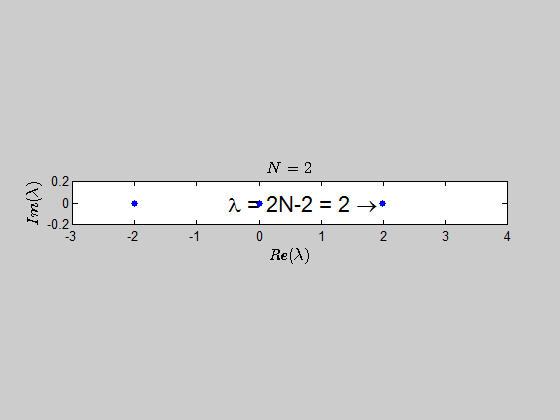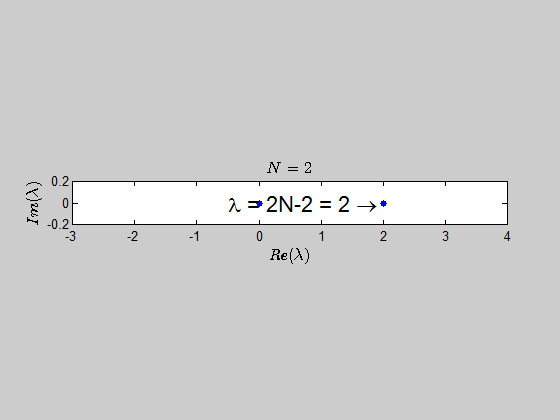Denote the linear space of linear operators on the linear space $V$ with field $\mathbb{F}$ by $L(V)$ and the linear space of $n \times n$ matrices with entries in $\mathbb{R}$ by $\mathbb{R}^{n\times n}$. Let $T:V \to V$ be an operator on the linear space $V$ over $\mathbb{R}$. Let $C_T(x)=\det(x I – T)$ be its characteristic polynomial. The coefficients of $C_T$ are in $\mathbb{R}$ since by definition $C_T(x)=\det\left(\mathcal{M}_B^B(xI-T)\right)$ and all the entries of $\mathcal{M}_B^B(xI-T)$ are in $\mathbb{R}$, where $\mathcal{M}_B^B$ is a linear isomorphism between $L(V)$ and $\mathbb{R}^{n \times n}$ with $B$ being a basis for $V$. Consequently, if $\lambda \in \mathbb{C} – \mathbb{R}$ is a root of $C_T$ then $\bar\lambda$ is also a root of $C_T$ with the same algebraic multiplicity. Now, I want to show that
$$\dim \ker (\lambda I – T)^{(m)} = \dim \ker (\bar \lambda I – T)^{(m)}, \qquad m = 1,\dots,r \tag{1}$$
where $r$ is the algebraic multiplicity of $\lambda$ and $\bar \lambda$. According to the spectral decomposition theorem, we have $V = \cdots \oplus V_\lambda \oplus \cdots \oplus V_{\bar \lambda} \oplus \cdots$, where $V_{\lambda} = \ker (\lambda I – T)^{(r)}$ and $V_{\bar \lambda} = \ker (\bar \lambda I – T)^{(r)}$. Let $B=(\cdots, B_{\lambda},\cdots,B_{\bar \lambda},\cdots)$ be the corresponding basis of this decomposition. Equation $(1)$ literally means that the blocks $\mathcal{M}_{B_\lambda}^{B_{\lambda}}(T|_{V_{\lambda}})$ and $\mathcal{M}_{B_{\bar \lambda}}^{B_{\bar \lambda}}(T|_{V_{\bar \lambda}})$ have complex conjugate Jordan sub-blocks of the following form
\begin{align}
J_{\lambda} =
\begin{bmatrix}
\lambda & 1 & \cdots & 0 \\
0 & \lambda & \ddots & \vdots \\
\vdots & \vdots & \ddots & 1 \\
0 & 0 & \cdots & \lambda
\end{bmatrix}_{d \times d}, \qquad
J_{\bar \lambda}=
\begin{bmatrix}
\bar \lambda & 1 & \cdots & 0 \\
0 & \bar \lambda & \ddots & \vdots \\
\vdots & \vdots & \ddots & 1 \\
0 & 0 & \cdots & \bar \lambda
\end{bmatrix}_{d \times d}, \qquad
J_{\bar \lambda} = \overline{J_{\lambda}}
\end{align}
or more compactly,
$$\mathcal{M}_{B_{\bar \lambda}}^{B_{\bar \lambda}}(T|_{V_{\bar \lambda}}) = \overline{\mathcal{M}_{B_\lambda}^{B_{\lambda}}(T|_{V_{\lambda}})}$$
How can I prove equation $(1)$?


Best Answer
The idea is that you can get the result by using two standard operations you are already familiar with: (i) transposition $^T$ (which you know doesn't change rank) and (ii) conjugate transposition $^*$. These are both involutions.
Now consider arbitrary $B\in\mathbb C^{n\times n}$ where $\text{rank}\big(B\big)=r$ and use the fact
I.e. using two well chosen permutation matrices $PBP'=\begin{bmatrix} B_r &* \\ * &* \end{bmatrix}$ has $B_r$, the leading $r\times r$ principal submatrix, invertible. (Note that $*$ denotes entries we don't care about; this nearly overloads notation for conjugate transpose but the context should make it clear.) So
$$\text{rank}\big(B\big) =\text{rank}\big(PBP'\big) =\text{rank}\big( B_r\big) =r $$
Since $B_r$ is invertible we know $B_r$ is similar (unitarily if you like) to an upper triangular matrix with no zeros on the diagonal. Then $B_r^*$ is similar to a lower triangular matrix with no zeros on the diagonal so $B_r^*$ is invertible.
This tell us that $\big(PBP'\big)^*=(P')^*B^*P^*$ has a leading $r\times r$ principal submatrix with rank $r$. It could conceivably have an even larger submatrix that has non-zero determinant so applying the blocked quote
$$\text{rank}\big(B\big)=r\leq \text{rank}\big((P')^*B^*P^*\big)=\text{rank}\big(B^*\big)\leq \text{rank}\big(B\big)$$
where the right hands side comes by re-running the argument on $B^*$ (i.e. making use of the involution).
Conclude: the conjugation map that sends $i\mapsto -i$ (aplied component-wise to a matrix) doesn't change rank of $B$, because it can be written as $\overline B=(B^*)^T$
Or if you prefer, we can conclude with:
\begin{align} \text{rank}\Big(\big(\lambda I -A\big)^m\Big) &=\text{rank}\Big(\big((\lambda I -A)^m\big)^*\Big) \\ &=\text{rank}\Big(\big((\lambda I)^* -A^*\big)^m\Big) \\ &=\text{rank}\Big(\big(\overline \lambda I -A^T\big)^m\Big) \\ &=\text{rank}\Big(\big((\overline \lambda I -A^T)^m\big)^T\Big) \\ &=\text{rank}\Big(\big( (\overline\lambda I)^T -(A^T)^T\big)^m\Big) \\ &=\text{rank}\Big(\big(\overline \lambda I -A\big)^m\Big) \end{align}
where, the third equality holds since $A$ has real components.